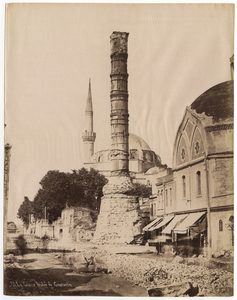Born in Constantinople, he started working as a photographer in 1860. Between about 1888-1908, he joined forces with the French photographer, Policarpe Joaillier. Together their studio produced images signed Sebah e Joaillier.
In 1857 photographer Pascal J. Sébah opened a studio in Constantinople, today Istanbul, Turkey. Photographing city views, daily activities, and ancient ruins in the surrounding area, Sébah sold many of his prints to visiting tourists, a prosperous and common market for other contemporary photographers, such as the well-known Abdullah Frères, brothers Vhichen (1820–1902), Hovsep (1830–1908), and Kevork Abdullah. Tourists would select a range of prints from professional photo studies in the countries they visited and compile a travel album of their journey.
In 1888, two years after Pascal J. Sébah passed away, his 16-year old son Jean (Johannes) became involved in the studio work. Jean started a partnership with another photographer from Istanbul, the Frenchman Policarpe Joaillier, which became a great success. Jean worked both on assignments for the studio and as an individual photographer, which can be determined from the signatures on the works: some prints were signed “Sébah & Joaillier,” others have the signature “J.P. Sébah.” The studio flourished and Sébah & Joaillier were named as the official photographers of the Ottoman Empire by the Turkish sultan. In the early 1900s Joaillier returned to Paris and Sébah continued his work in Constantinople. After different partnerships, the studio was taken over by Ismail Insel and renamed “Foto Sabah” (sabah means “morning” in Turkish). Jean Sébah died in 1947, at the age of 75. In 1952 the studio closed its doors.
Claartje van Dijk



